Info
Subfamily: Panicoideae
Genus etymology: Saccharum = "sugar" [Latin] refering to the species cultivated for their sweet culms
Species etymology: spontaneum = "spontaneous" [Latin] refering to it being a wild, uncultivated species
Photosynthetic type: C4 (warm season)
Nativity: naturalized - intentional
First recorded in Hawaiʻi: 1937
Legal status: USDA - noxious weed
Map
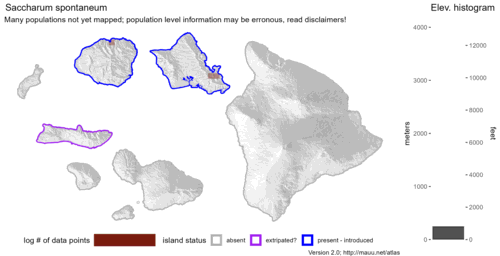
Inflorescence
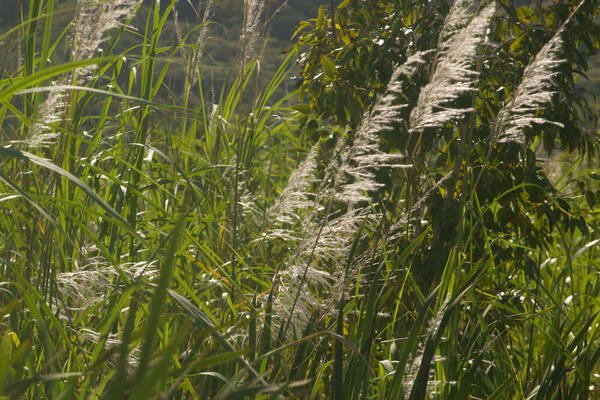
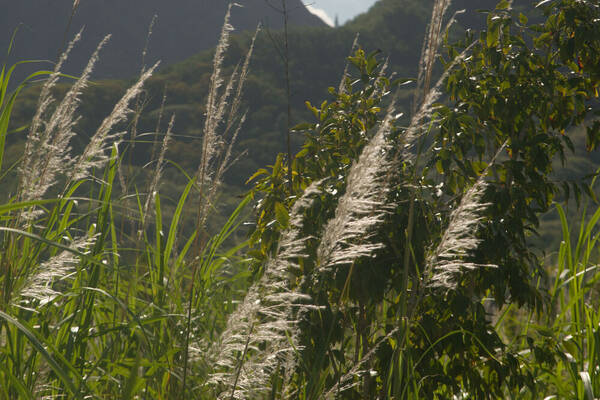
Plant

Habit
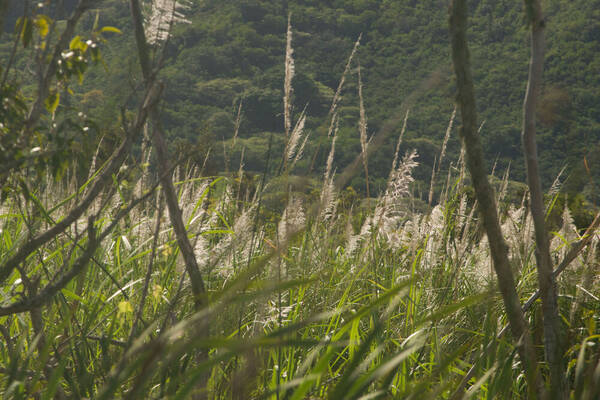
Spikelets
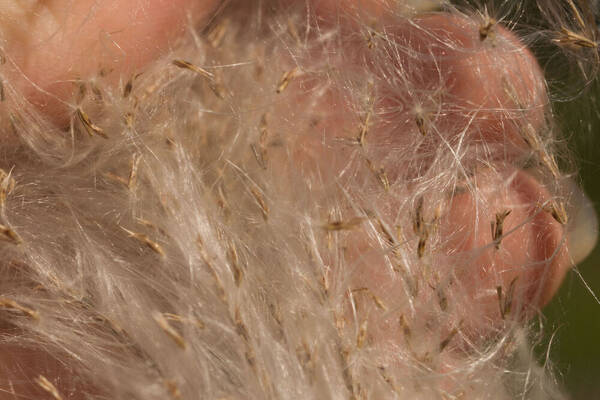
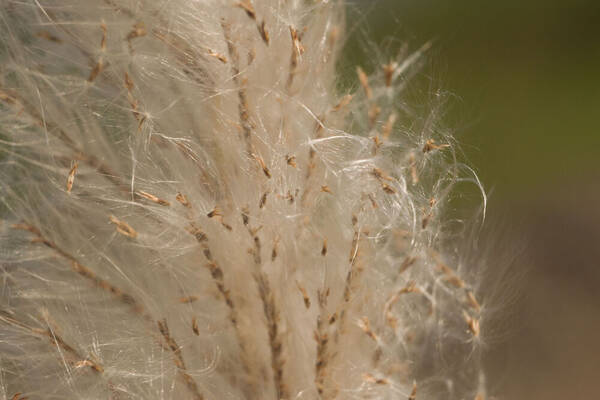
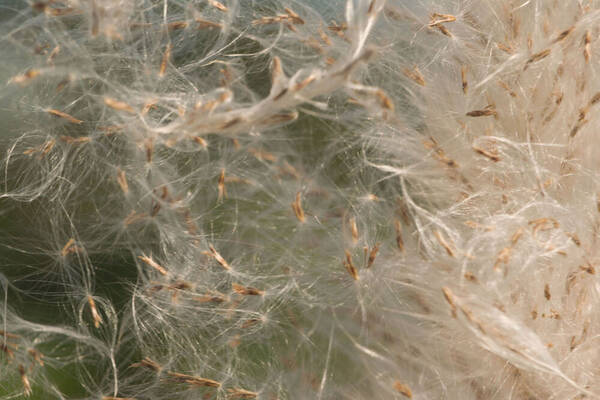
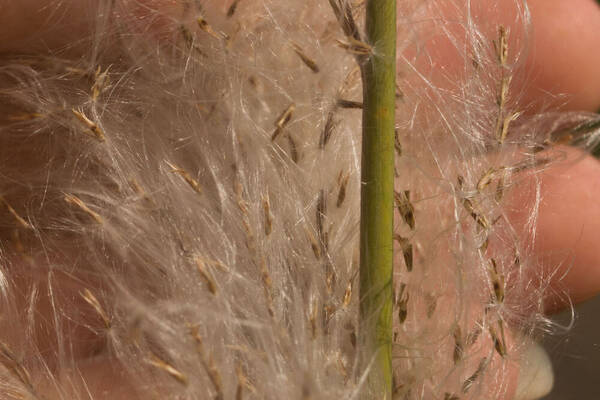
Description
Tall rhizomatous perennial; culms 2–4 m. high or more. Leaf-blades 50–90 cm. long, 5–15(–40) mm. wide. Panicle 25–60 cm. long, the axis hirsute; racemes 3–15 cm. long, usually much longer than the supporting branches, the internodes and pedicels hirsute. Spikelets 3.5–7 mm. long, the callus bearded with silky white hairs 2–3 times as long as the spikelet; glumes subcoriaceous in the lower third, glabrous on the back, ciliate on the margins above; upper lemma subulate and up to 3 mm. long, or suppressed.
(Description source: Clayton, W.D. & Renvoize, S.A. 1982. Flora of Tropical East Africa. Gramineae (Part 3). A.A. Balkema, Rotterdam. 448 pp. )
Rhizomatous perennial. Culms 200–400 cm high or more. Leaf laminas 5–15(40) mm wide. Panicle 25–60 cm long, the axis hirsute; racemes 3–15 cm long, usually much longer than supporting branches, the internodes and pedicels hirsute. Spikelets 3.5–7 mm long, the callus barbate with silky white hairs 2–3 times as long as the spikelet. Glumes subcoriaceous in the lower third, glabrous on the back, ciliate on the margins above. Superior lemma subulate and up to 3 mm long, or suppressed.
(Description source: Cope, T.A. (ed.). 2002. Flora Zambesiaca. Volume 10. Part 4. Kew, London. 190 pp. )
Plants with long rhizomes. Culms 2-4 m tall, 0.6-2 cm thick, solitary or few together. Sheaths usually glabrous; ligules 1.5-3 mm; blades 50-100 cm long, 10-25 mm wide, usually glabrous, markedly hirsute above the ligules. Peduncles pilose; panicles 40-70 cm, narrowly oblong to widely ovate, rachises 25-50 cm, densely pilose; primary branches 2.5-7 cm. Sessile spikelets 3.5-7 mm. Callus hairs to 12 mm; glumes glabrous over the back, ciliate toward the tip; lower lemmas about 3 mm; upper lemmas subequal to the lower lemmas, entire; awns absent; anthers 3. Pedicels 1.5-3 mm, ciliate. Pedicellate spikelets similar to the sessile spikelets. 2n = 20, 24-30, 32, 36, 38, 40, 48-60, 64, 69.
(Description source: Barkworth, M.E., Capels, K.M., Long, S. & Piep, M.B. (eds.) 2003. Flora of North America, north of Mexico. Volume 25. Magnoliophyta: Commelinidae (in part): Poaceae, Part 2. Oxford University Press, New York. 783 pp http://floranorthamerica.org/Saccharum_spontaneum )
Rhizomatous perennials; culms erect, 20-40 dm tall or more. Sheaths green to yellow, margins overlapping, glabrous; ligule 3-4 mm long, chartaceous, apex rounded, erose, fringed with scattered hairs, and accompanied by a dense fringe of hairs 2-3 mm long behind the ligule; blades 50-90 cm long, 5-15(-40) mm wide. Inflorescences paniculate, 25-60 cm long, axis hirsute, the racemes 3-15 cm long, usually much longer than the supporting branches, internodes and pedicels hirsute, rachis breaking up into units consisting of a spikelet pair and 1589 the rachis section below the next spikelet pair; spikelets 3.5-7 mm long, callus bearded, the hairs silky, 2-3 times as long as the spikelet; glumes subcoriaceous in the lower 1/3, glabrous on the back, ciliate on upper margins; first lemma ca. 3.2 mm long, hyaline, fimbriate; second lemma narrow, up to 3 mm long, fimbriate, hyaline; palea absent. Caryopsis not seen. [22 = 40-130.]
(Description source: O’Connor, P.J. 1990. Poaceae, pp. 1481–1604. In: Wagner W.L., Herbst D.R. & Sohmer S.H. (eds.)., Manual of the flowering plant of Hawaiʻi. Vol. 2. University of Hawaii Press & Bishop Museum Press, Honolulu )